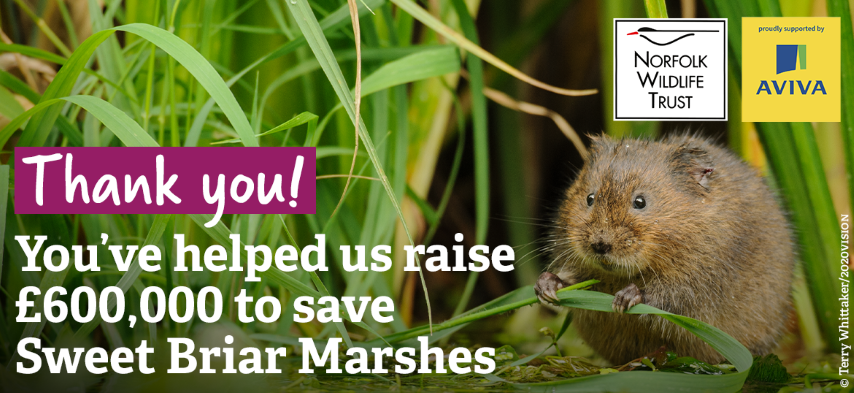As part of our Claylands Wilder Connections Project we are running Citizen Science Campaigns. Each season we’re asking you to record your sightings of three species that make a home in the South Norfolk Claylands, to help us get a better picture of the areas that support these creatures and to help guide future conservation work.
Starlings, jays, and greenfinches are the next set of species to be selected because of their association with autumn and the species’ need for large areas of connected habitat here in South Norfolk.
You can share your sightings:
1) On our online Spotter Survey www.norfolkwildlifetrust.org.uk/wilderconnections
2) By emailing wild@norfolkwildlifetrust.org.uk
3) By calling Sue Grime, Wilder Connections Engagement Officer, on 07393 807897.
We’ll need to know what you saw where and when.
Starlings are familiar birds of farmland, parkland, gardens and towns. Sociable birds, starlings spend a lot of their time in large flocks, roosting and performing sweeping, aerial displays – they can often be seen moving fluidly through a wintry sky. Large murmurations of up to 100,000 birds can be seen flying and roosting together, but they may not sound like starlings. They are great mimics and regularly include calls of other birds in their repertoire; they have also been recorded mimicking the sounds of mobile phones, wolf whistles and even domestic cats. We’d like to know when and where you’ve seen these birds whether it’s one or one thousand.
Since the 1980s starling populations have suffered dramatic declines – of around 66%, according to the British Trust for Ornithology. They are listed as Red under the Birds of Conservation Concern 4: the Red List for Birds (2021). They are protected in the UK under the Wildlife and Countryside Act, 1981 and are a Priority Species under the UK Post-2010 Biodiversity Framework. The reason for this decline is unknown, but could be related to a lack of food. They like to eat invertebrates, more specifically those that live in the soil, such as worms and leatherjackets (crane fly/daddy long legs larvae) and it is possible that these species may have declined due to drier summers associated with the effects of global climate change and other factors that have created significant declines in insects, such as use of pesticides. The charity Buglife as part of its No insectinction campaign states that up to 41% of the worlds’ insect species could be lost in the next few decades. Butterflies, moths, bees, wasps and dung beetles are most at risk, along with freshwater insects such as stone flies, caddisflies and mayflies – all of which form a significant part of complex food webs.
Jays are surprisingly shy birds that also eat invertebrates, especially caterpillars and beetles, and are famous for enjoying acorns (and other nuts and fruits) during the autumn; they will also cache their finds for later. Jays are present all year-round, but are most obvious in autumn when they have to move about in the open more often, looking for food. They are classified in the UK as Green under the Birds of Conservation Concern 4: the Red List for Birds (2021), indicating that their population is currently stable. Threats that may impact on the population of jays include: loss of wooded habitat, persecution and poor acorn crops.
Due to their shyness, as well as enjoying habitats with lots of cover where they can hide, they are not common to spot. They have been selected for the autumn spotter survey due to the fact that they are a key species for the lifecycle of a woodland, they bury acorns during the autumn so they have winter stocks but they are often left forgotten in the ground. These forgotten are then left to grow, introducing new trees into the jays’ woodland habitat. We are also interested on how they are faring given the lack of acorns in 2021.
Through the Wilder Connections project we are introducing native hedgerow trees and improving woodlands to help the habitats where jays and other species live.
Greenfinches A common, large finch of gardens, parks, woodland and farmland, the greenfinch feeds on seeds, and will visit bird tables and feeders in gardens. In winter, they form flocks with other finches, and can be seen roaming the countryside and parklands for food. Despite the fact that they should be a common sight in gardens, they are classified in the UK as Red under the Birds of Conservation Concern 5: the Red List for Birds (2021), and protected in the UK under the Wildlife and Countryside Act, 1981.
As the year moves towards its final months these birds will begin to flock together with other finches making them easier to spot in larger numbers. It is especially important for us to find out how many of these birds remain in Norfolk following a significant decline in numbers. Greenfinches have declined by 63% since the 1970s. The continued decline may be due more recently (2005) to an outbreak of a parasite-induced disease which prevents them from feeding properly, the disease is called Trichomonosis which can spread through shared food and water.
Greenfinches are becoming scarce in gardens all across Norfolk due to the spread of this devastating disease. So, we’d like to know where they are so we can try to boost numbers through habitat actions within the Wilder Connections project areas.


Comments are closed